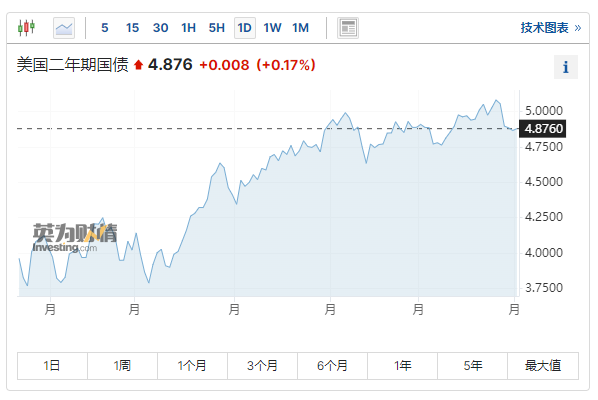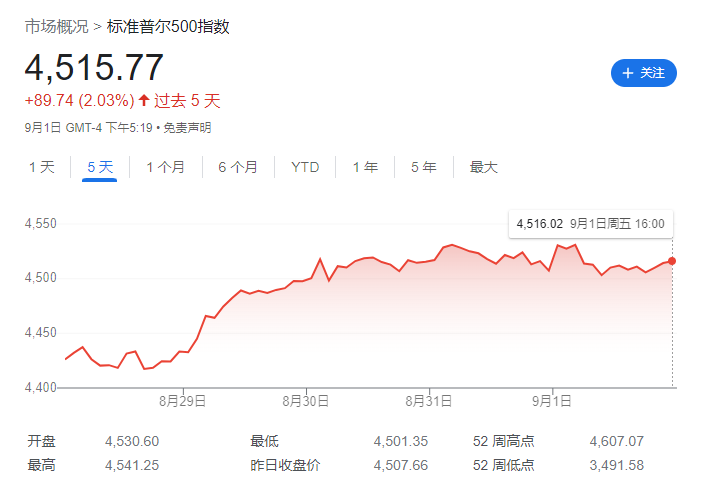"Economic data" is just right, all pointing to the Federal Reserve stopping rate hikes, and Wall Street is excited again.
On Friday, the "cooling" non-farm report altered market sentiment, prompting some of the world's largest bond investors to increase their bets that the Federal Reserve's tightening cycle is nearing its end, and to increase their holdings of policy-sensitive two-year US Treasury bonds.
With the cooling of the US labor market in August, the market's expectation of the Federal Reserve's interest rate hike has further strengthened, and Wall Street has become more optimistic about the trend of US stocks and bonds.
The non-farm payroll report released on Friday showed that the US unemployment rate unexpectedly soared by 0.3% to 3.8% in August, reaching a new high since February last year, and wage growth was slow, with average hourly wages falling by 4.3% compared to the previous month.
This is the third report this week indicating a cooling of the US job market. Previously, reports showed that US job vacancies were lower than expected, and the ADP Research Institute reported a slowdown in US company employment growth.
In recent months, despite the continuous decline in US inflation, the robust job market has always been the main obstacle to the Federal Reserve's interest rate hike. However, the non-farm payroll report on Friday, which showed a cooling trend, changed market sentiment and prompted some of the world's largest bond investors to increase their bets that the Fed's tightening cycle is coming to an end. They increased their holdings of two-year US Treasury bonds, which are sensitive to policy changes. Jeff Rosenberg of BlackRock called it a "screaming buy." He said:
The reason for favoring two-year Treasury bonds is that they not only have high yields but also have the potential to benefit from the Fed's policy shift.
Due to the uncertainty of inflation and risk premiums, long-term bonds are less attractive.
On Friday, short-term US Treasury bonds performed well, causing the yield curve to steepen. The yield on two-year Treasury bonds fell by about 20 basis points this week, dropping below 4.9%. At the same time, the yield on 30-year Treasury bonds remained relatively stable this week, at around 4.30%, surpassing five-year Treasury bonds for the first time in several weeks.
Currently, Pacific Investment Management Company (PIMCO) manages $1.8 trillion in assets. Michael Cudzil, a portfolio manager at the firm, said:
"The employment data satisfies the bond market's view that the Fed will pause its interest rate hikes and may end the entire cycle...
If they end the rate hike cycle, the next focus will be on the first rate cut, which will cause spreads to widen."
George Goncalves, head of macro strategy at Mitsubishi UFJ Financial Group (MUFG) in the US, said the employment report looks like "the end of a strong job market and the beginning of the countdown to the Fed's pause in interest rate hikes." He said, "This will benefit short-term bonds rather than long-term bonds." He added that the yield on two-year Treasury bonds could fall to 4.5%.

"Perfect" Golden Girl Status?
The data also strengthens Wall Street's narrative of the US economy being in a "just right" scenario, where economic growth is good and inflation and interest rates are weak.
On Friday, Stephen Suttmeier, a technical analyst at Bank of America, released a report stating that based on the current "golden girl" scenario of the US economy, the stock market is expected to reach a new all-time high by the end of this year:
When the stock market rises by 10%-20% in September, 65% of the time in that month has a positive return... In September 2023 and for the remainder of this year, the stock market will show a bullish trend.

Currently, it is widely expected in the market that the Federal Reserve will abandon rate hikes at its September meeting and keep the federal funds rate between 5.25% and 5.5%. Gargi Chaudhuri, Head of Investment Strategy for the Americas at BlackRock's iShares, said:
"The Fed no longer needs to take extreme measures, it is now time for the current restrictive rates to continue to play their role."
In addition, a inflation report released on Thursday showed that although consumer spending on daily goods and services has been active this summer, price increases have slowed down. Economists and investors believe that the Fed can "take a break" before causing more pain to the economy.
Jan Hatzius, Chief Economist at Goldman Sachs, said:
"Currently, they really have no reason to implement further tightening policies... It makes a lot of sense to remain cautious for a long time."
It should be noted that the current evidence may not be sufficient to prove that the Fed's rate hike process has ended. At the Jackson Hole Global Central Bank Annual Meeting held last week, Powell expressed concerns about "strong US consumer spending, an economy far exceeding long-term trends, and hindered inflation decline," and suggested that further monetary tightening may be needed.

